Continuing Swiss Week, we have more detailed information on the LMG25 light machine gun today. There design was officially adopted by the Swiss Army in 1925 (as you might have guessed) after about 7 years of development under the direction of Adolf Furrer at Waffenfabrik in Bern, and was not taken fully out of service until the 1970s. As best we can tell, it was a reasonably reliably gun – at least enough so to remain the main Swiss light machine gun throughout World War II. The guns were manufactured from 1924 until 1946, with about 23,000 made in total. There are a couple uncommon variants, including a cavalry model with a folding butt and some made during WW2 with rails for mounting optical sights. It is chambered for the standard Swiss 7.5x55mm cartridge, and uses 30-round box magazines mounted on the left side of the receiver.
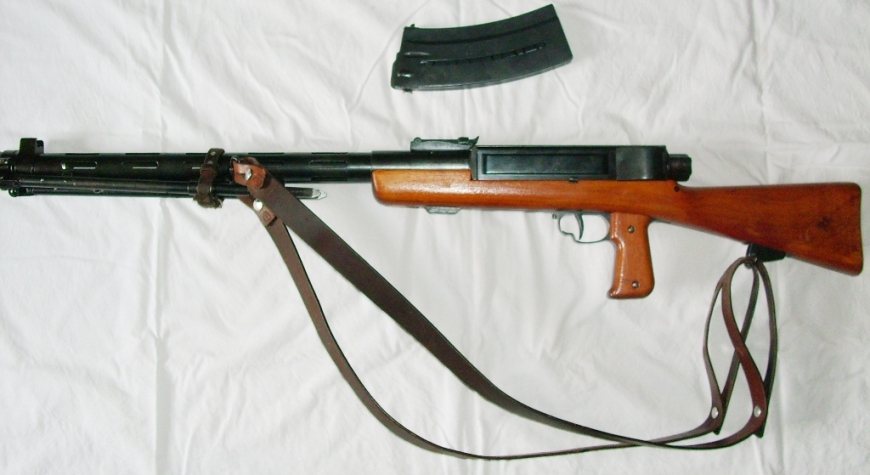
Mechanically, the LMG25 is recoil operated and toggle locked, although it is a bit different than most other toggle locked designs. Upon firing, the barrel, barrel extension, and bolt assembly all move backwards a short distance, and a cam on the inside of the receiver forces the toggle joint to break, unlocking the action. At this point in most guns, the barrel would stop and the bolt would continue rearward under intertia, but the LMG25 is different. The barrel and bolt parts remain connected at all times – so the barrel continues recoiling backwards under the bolt is fully open. The geometry of the toggle lock legs is such that the bolt is accelerated open faster than the barrel moves backwards, allowing the empty case to clear the chamber and eject. At the end of travel, a recoil spring in the rear pushes the whole assembly forward, forcing the bolt shut again and chambering a new cartridge.
This twist on the recoil operating mechanism helps improve the reliability of the gun by having the momentum of the whole barrel driving the extraction and ejection all the way back. In most short recoil actions, dirt can stop the system once the barrel finishes moving because the mass of the bolt alone is much less, and thus more easily stopped by friction.
I should also note that the LMG25 fires from an open bolt, so when the trigger is released the action will stop fully open. The selector lever is (unusually) located on top of the magazine well, with settings for safe, semiautomatic, and fully automatic fire.
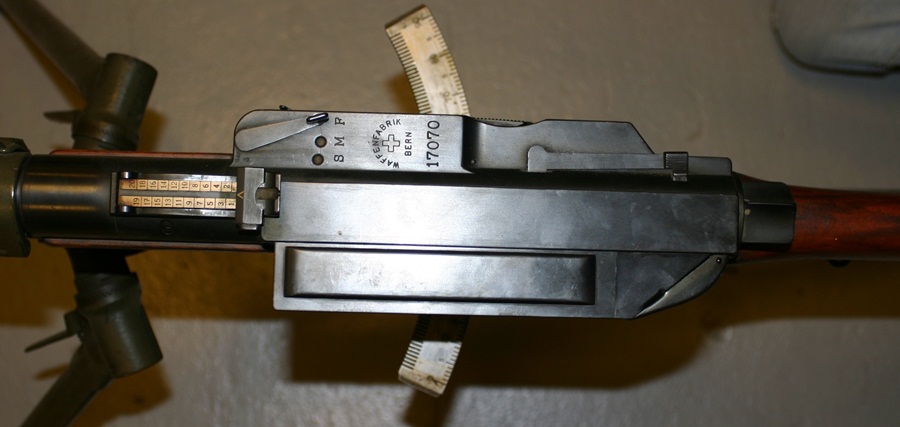
The gun is thoughtfully equipped with covers for all openings, to help keep it clean when not firing. Because the bolt assembly extends way out both sides of the receiver when open, the cutout for the ejection port is much larger than on other light machine guns. It is protected by a two-part cover, which has to be closed manually but opens automatically when the bolt handle is operated:
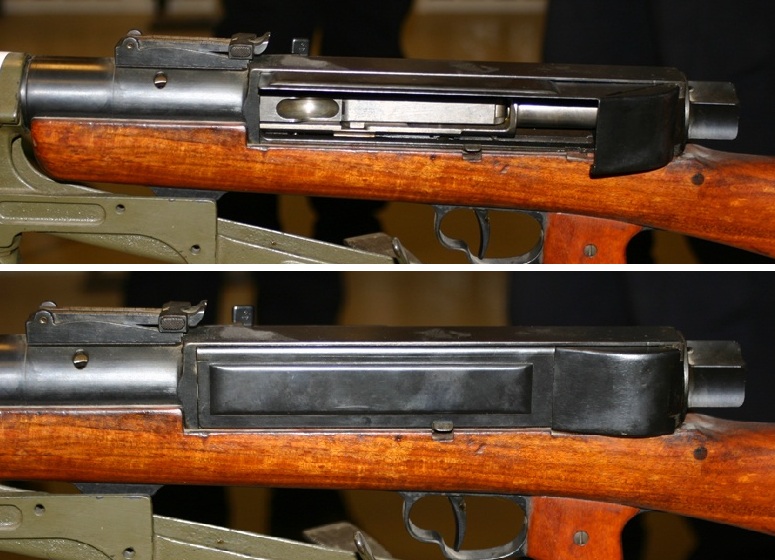
Disassembly is very simple. There is a large nut at the back of the receiver that can be removed by hand. The recoil spring comes out after that nut is removed, and then the whole barrel and bolt assembly slides out the back. At that point the gun is field stripped. The most common machine gun problems – such as a broken extractor or firing pin – can be dealt with by simply replacing the whole assembly until you have the time to replace small parts or leave the broken assembly with a unit armorer (not that I expect parts breakage would be an issue with the LMG25).
Interestingly, the rear monopod supplied for the gun (a common idea at the time, to allow reasonably stable fire for an emplaced gun without the need for a bulky tripod), couple also be attached to the handguard out front for use a vertical grip for assault fire:
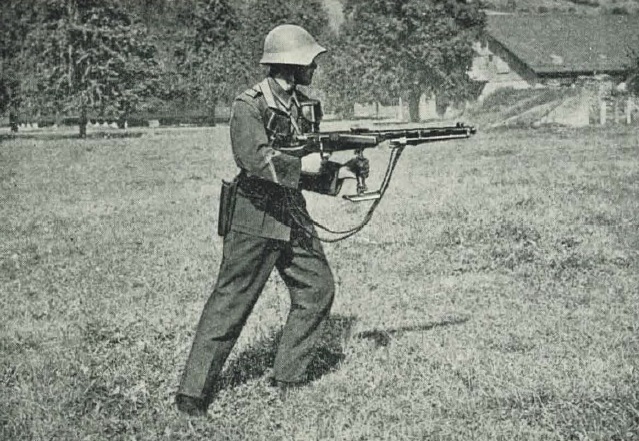
Having mentioned the folding-stock cavalry version up above, I should take a moment to elaborate. We normally think of a folding stock moving 180 degrees, so it is flat against the side or bottom of the stock for more compact transport. Well, the LMG25 folding stock is a bit different. It was designed to fit a cavalry scabbard, so instead of fully folding, the buttstock only goes 90 degrees, dropping down parallel to the pistol grip:
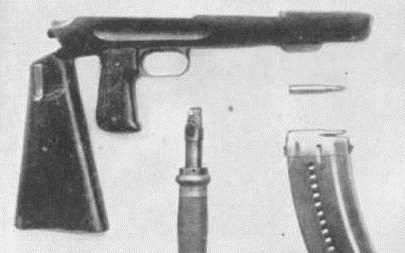
In addition to a gallery of photos of the gun at Cornet & Co (click here to download the high-res gallery), we also have a pair of manuals available for the LMG25, a very thorough one in French (with a bunch of photos at the end of different firing setups) and a shorter technical manual in German (nothing in English, sorry). You can download them both here, or on the LMG25 page in the Vault.
[nggallery id=153]
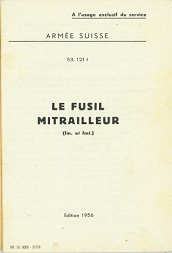
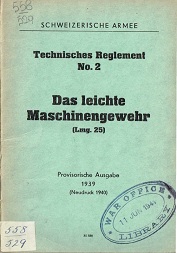

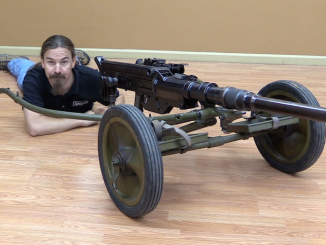
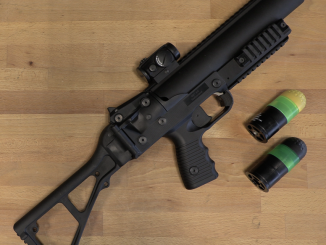

What a beautiful rifle (not that the Swiss – or the Finns ever built anything ugly, or less than immaculately finished) Thanks for sharing.
Toggles for locked breech automatic operation all have an “accelarator” as an implicit part of the design.
Maxim type machineguns and the Borchardt and Luger pistols use the cam which breaks the toggle to impart some of the momentum of the recoiling barrel and slide to accelerate the toggle and bolt during the critical moment of primary extraction.
This factor does not seem to have been missed by those designing none toggle replacements for Maxims, Lugers etc.
John Moses Browning, neatly avoids the need for an accelerator in his locked breech pistols, by concentrating most of the recoiling mass in his combined slide and bolt, rather than the barrel.
a pistol slide was not a practical option for a machinegun, and Browning incorporated a separate accelerator to slow the barrel and ensure full cycling of the bolt and operation of the feed mechanism.
Browning appears to have been well acquainted with toggle designs, in his lever actions, the potato digger etc. One of his last patents before his death was for a toggle mechanism.
Lahti had previously worked on a Finnish adaptation of a Maxim action, and appears to have been particularly enamoured with the use of accelerators in his recoil operated action designs.
It looks like you’ve found the most explicit use of the accelerator which is implicit within the toggle.
That is a very beautifully crafted (and comparatively light) design.
I have to say that I’m always curious how deep the Swiss reputation really runs when their designs are tested in total warfare. We can go on about the sub MOA K31 and Switzerland’s history of being the first to adopt the Luger design, but I’m curious as to how reliable they really are, or how quality would diminish should Switzerland ever face a situation such that that the USSR faced when the Nazis were only 2 weeks away from Moscow.
I’ve heard great things about the 550 series cold weather reliability, and the extreme torture testing they did when selecting the rifle (nothing speaks to that than burying a rifle in snow on the Alpine heights, digging it up some time later and still expecting the same accuracy out of a cold barrel compared to standard conditions), but how would this reputation hold up in dire times?
Have Been in switserland a few times, and drove trough so many narrow mountainpasses, that i dont think the size of the invading force doesnt matter much. *to add to that that i am told that the consript men have the option to take their sirvice rifle home (when there mandatory time is up), and ammo depots scatterd around. Does not sound very alluring to move in.